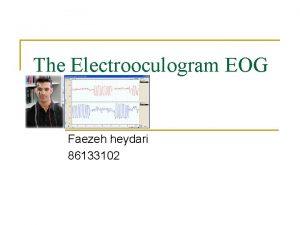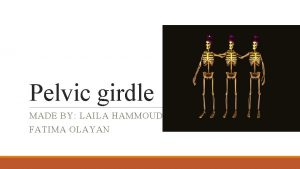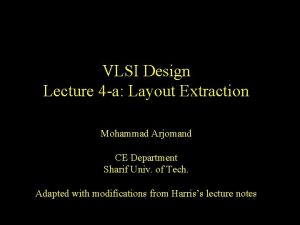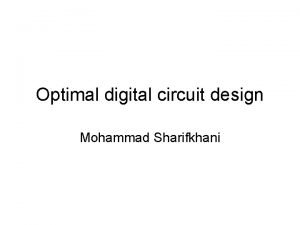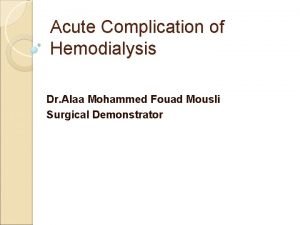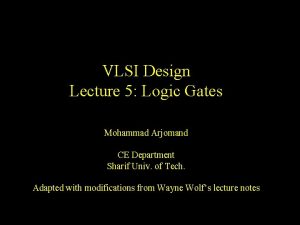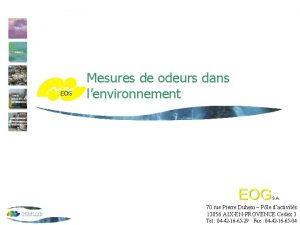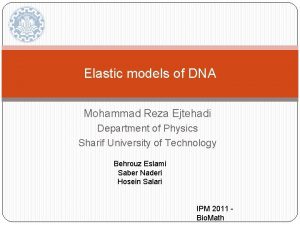Applications of ERG mf ERG EOG Mohammad Reza











































- Slides: 43


Applications of ERG, mf. ERG & EOG • Mohammad Reza Akhlaghi MD 2

Applications of ERG • The basic method of recording the electrical response is by stimulating the eye with a bright light source. • The flash of light elicits a biphasic waveform recordable at the cornea. • The two components that are most often measured are the a- and b-waves. The a-wave is the first large negative component, followed by the b-wave which is corneal positive and usually larger in amplitude 3

4

• Two principal measures of the ERG waveform are taken: • 1) The amplitude • 2) the implicit 5

6

introduction Origin of waveforms in ERG • The a-wave, photoreceptors • The b-wave inner layers of the retina, including bipolar cells and the Muller cells • Oscillitatory potentials are thought to reflect activity in amacrine cells 7

Standard Type Of Responses dark-adapted & light-adapted • • • Rod response (dark-adapted) Maximal combined response (dark-adapted) Oscillatory potentials (dark-adapted) Single-flash "cone response" (light-adapted) 30 -hertz (-Hz) flicker responses (light-adapted) 8

9

Cautions • density of cones & rods the fovea and macula, • 90% of cones lie beyond the macula in large macular lesions ERG b-wave amplitude would be reduced only about 10%. • ERG does not necessarily correlate with visual acuity, which is a function of the fovea. 10

Applications • The ERG is important for diagnosing and following retinal dystrophies and degenerations. • Not a direct test of macular function • The ERG is also useful in assessing disorders of dark adaptation, color vision, and visual acuity, and evaluation of hysteria or malingering. 11

12

ERGs in retinitis pigmentosa-like diseases 13

14

15

ERGs in retinitis pigmentosa-like diseases • differential diagnosis of RP : Syphilis, particularly the congenital form, can mimic the fundus appearance of RP. In rubella and early stages of syphilis the ERG is usually normal or only slightly subnormal. 16

17

Congenital stationary night blindness (CSNB) Often seen with a normal appearing retina • Based on ERG there are two types. • Type 1: abnormal dim scotopic ERGs but maintains oscillatory potentials. • Type 2: very abnormal dim scotopic ERG and maximum response has a large a-wave and no b-wave (negative ERG). Oscillatory potentials are also missing. 18

Congenital stationary night blindness (CSNB) 19

Cone & Cone-Rod dystrophy Cone dystrophies : inherited in all forms, poor color vision & poor acuity. Bulls eye appearance or diffuse pigmentation in the macular area • Nystagmus and photophobia. • • 20

Cone & Cone-Rod dystrophy • Rod response is good but just slower. However, the early “cone” portion (bx) of the scotopic red flash ERG is missing. • Maximum response is fairly normal but with slow implicit times. • 30 Hz flicker and cone response are very poor. 21

Cone & Cone-Rod dystrophy 22

CRAO & Ophthalmic artery occlusion • ERG with no b-wave (negative ERG) • Ophthalmic artery occlusions usually result in unrecordable ERGs. 23

CRAO 24

X-linked juvenile retinoschisis • A splitting or schisis in the central retina with a characteristic fundus appearance. They have poor acuity. The ERG has a specific abnormality showing a normal a-wave but no b-wave (negative ERG). • The picture is similar to that recorded in CRAO and CSNB Type 2 25

26

ERG in IOFB • The ERG is useful to assess cases of retinal foreign bodies and trauma to estimate the extent of retinal dysfunction. • In general if b-wave amplitudes are reduced 50% or greater compared to the fellow eye, it is unlikely that the retinal physiology will recover unless the foreign body is removed 27

28

Chloroquine retinopathy • A number of drugs given in high doses or for long periods of time can produce retinal degeneration with pigmentary changes. Chloroquine retinopathy shows as a characteristic “bulls eye” appearance of the macula. The full-field ERGs may become abnormal in these cases 29

Chloroquine retinopathy 30

Extinguished ERG a few disorders result in a completely. They include the following: 1) Leber’s congenital amaurosis 2) Severe retinitis pigmentosa 3) Retinal aplasia 4) Total detachment of retina 5) Ophthalmic artery occlusion 31

The multifocal ERG (mf. ERG) • limitation of full-field ERG is a mass response. • Unless 20% or more of the retina is affected with a diseased state the ERGs are usually normal • a legally blind person with macular degeneration, enlarged blind spot or other small central scotomas will have a normal full-field ERG 32

The multifocal ERG • The most important development in ERGs is the multifocal ERG (mf. ERG). • With this method one can record mf. ERGs from hundreds of retinal areas in a several minutes. • Small scotomas in retina can be mapped and degree of retinal dysfunction quantified. 33

The multifocal ERG • A topographic ERG map of the • Multifocal ERG tests cone-generated responses that subtend 25° radially from fixation. • In patients with stable and accurate fixation • Objective test for macular dysfunction (for patients with decreased VA & NL funduce ) 34

35

36

37

ELECTROOCULOGRAM • The electrooculogram measures the potential between cornea and Bruch’s membrane. • Origin of the EOG: RPE , but requires both a normal RPE and normal mid-retinal function. • Movement of the eye produces a shift of electrical potential. • By attaching skin electrodes on both sides of an an eye the potential can be measured by having the subject move his or her eyes horizontally 38

39

40

• The major limitation of the EOG as a clinical tool is that the origin and meaning of this electrical response are not well understood • The relationship of the EOG to physiologic functions of the RPE is unclear because it does not correlate closely with either pigmentary changes in the RPE or visual function. 41

• The most common use of the EOG nowadays is to confirm Best’s disease • There is considerable variation in the fundus appearance in Best’s disease. In most cases of vitelliform macular dystrophy the EOG is reduced but the ERG normal. 42

43
 Electrooculogram
Electrooculogram Means earth (eog)
Means earth (eog) Sandra davidson reviews
Sandra davidson reviews 8th grade science eog
8th grade science eog Saccad heyderi
Saccad heyderi Iaat score chart
Iaat score chart Georgia milestones eog score interpretation guide
Georgia milestones eog score interpretation guide Eog grading scale 1-5 nc
Eog grading scale 1-5 nc Eog grading scale 1-5
Eog grading scale 1-5 Eog 3rd grade reading
Eog 3rd grade reading Eog strategies
Eog strategies Nc eog scale scores percentiles 2021
Nc eog scale scores percentiles 2021 Means earth eog
Means earth eog Mohammad hammoud
Mohammad hammoud Dr. mohammad diab
Dr. mohammad diab Dr mohammad khan
Dr mohammad khan Sumbangan mohammad eunos abdullah
Sumbangan mohammad eunos abdullah Mohammad sadegh rasooli
Mohammad sadegh rasooli Mohammad arjomand
Mohammad arjomand Mohammad sharifkhani
Mohammad sharifkhani Mohammad ali javidian
Mohammad ali javidian Mohammad alomar
Mohammad alomar Mohammad sharifkhani
Mohammad sharifkhani Dr mohammad aman
Dr mohammad aman Mohammad alipour
Mohammad alipour Mohammad ghoreishi
Mohammad ghoreishi Dr nur mohammad hadi zahalan
Dr nur mohammad hadi zahalan Shaik mohammad tajuddin
Shaik mohammad tajuddin Mohammad ali abtahi
Mohammad ali abtahi Mohammad ridwan bkn
Mohammad ridwan bkn Phynetoin
Phynetoin Dr mohammad aman
Dr mohammad aman Mohammad keshavarz
Mohammad keshavarz Wali mohammad md
Wali mohammad md Pearo-nn
Pearo-nn Sharif
Sharif Mohammad irfan bowdoin
Mohammad irfan bowdoin Sqt pulmonary embolism
Sqt pulmonary embolism Vlsi
Vlsi Mohammad sharifkhani
Mohammad sharifkhani When do you homework
When do you homework Oh soberano santuario sagrario
Oh soberano santuario sagrario Muhammad reza kahar aziz
Muhammad reza kahar aziz Reza entezari maleki
Reza entezari maleki




